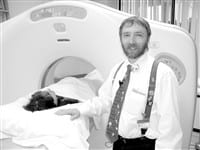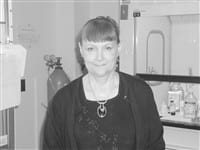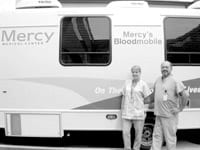Life In The Fast Lane Mercy’s New CT Imaging System Allows For More Testing In Far Less Time
Steven Allen, M.D. likens it to trading in a Yugo for a Ferrari.
That’s how he chose to describe Mercy Medical Center’s acquisition of a new, state-of-the-art computed tomography (CT) scanner. The new equipment, made by GE, replaces a scanner with the same model name — LightSpeed. But this one is so much quicker that Allen instead calls it “Ludicrous Speed,” a name borrowed from Mel Brooks Star Wars spoof Spaceballs.
“That’s how much faster it is,” said Allen, Mercy’s Radiology director, who told The Healthcare News that such speed brings a number of benefits for the patient and the physician treating him.
For starters, the hospital can now scan many more patients in an hour or day, he said. But the high speeds — he estimates that this machine is 16 times faster than the one it replaced — also allow for more accurate images.
That’s because, as Allen put it, body motion is the enemy in diagnostic imaging, and any equipment that allows more images to be taken in less time will help physicians make better, more accurate analyses.
“When someone’s hurt, or someone’s sick, lying still is not an easy thing to do … motion has been our enemy for as long as we’ve been in radiology,” he said. “It’s like taking a regular picture; if you go to snap a picture of someone and they move, that blurs the photo.
“And while that may be annoying, in a medical context, blurriness can have far more damaging consequences,” he continued. “A blurred image can completely change a diagnosis in CT. So the faster we can do it, the less discomfort there is for the patient, and the more accurate the diagnosis.”
Mercy took delivery of the $1.5 million scanner in April. Allen said that price tag was an issue, especially in these times of falling reimbursement rates from both public and private payers, but the cost can easily be justified when one looks at the number of benefits the new equipment brings to the medical center.
He said the enhanced speed enables Mercy to conduct CT scans in a more cost-effective manner. And while the quantity of tests increases — he projects a 20{06cf2b9696b159f874511d23dbc893eb1ac83014175ed30550cfff22781411e5} increase in volume over previous levels — the quality is also improved.
A CT exam creates images analogous to a single slice of bread from a loaf, said Allen, noting that this is why the term ‘slice’ is often used to describe a view of patient anatomy. What the new Light-Speed scanner does is allow physicians to take thinner slices and more of them in less time.
The 16-row, 912-channel detector captures more anatomical information per second than single-slice scanners, he said, and it can also be used for expandable slice acquisition for future growth.
Allen said the advanced technology not only means more diagnostic information for doctors in routine situations, but its speed can also save precious exam time in the emergency room. The new equipment allows doctors to simultaneously capture multiple images of a patient’s anatomy in a matter of minutes, he said.
“In many cases, emergency room physicians rely on images from CT scanners to assess the extent of internal injury during the first and most critical hour for trauma patients,” he explained. “Reducing the scan time by a few minutes or more can allow ER physicians to begin treating patients more quickly.”
CT exams are used when people are ill or injured, or when a doctor suspects a medical problem that is not easily detectable from a normal physical examination. The LightSpeed CT scanner assists physicians in the diagnosis of a variety of anatomic areas, including spine, head, abdomen, and chest.
“With LightSpeed, a CT exam that used to take us three minutes can now be completed in approximately 20 seconds,” said Allen. “This allows us the speed and accuracy we need to quickly diagnose a variety of conditions for emergency and non-emergency patients of all ages.




Comments are closed.